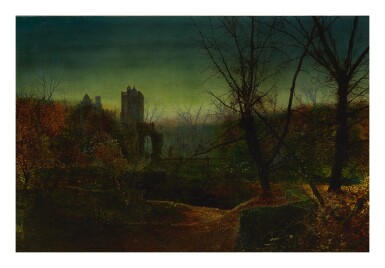19th Century European Art
19th Century European Art

Property of a Private Collector, New York
JOHN ATKINSON GRIMSHAW | KNOSTROP OLD HALL AT DUSK
Lot Closed
June 11, 04:05 PM GMT
Estimate
100,000 - 150,000 USD
Lot Details
Description
Property of a Private Collector, New York
JOHN ATKINSON GRIMSHAW
British
1836 - 1893
KNOSTROP OLD HALL AT DUSK
signed ATKINSON GRIMSHAW and dated 1870+ (lower right)
oil on canvas
canvas: 24 by 36 in.; 61 by 91.4 cm
framed: 35 ¾ by 47 ¾ in.; 91 by 121.2 cm
Vicars Brothers, London
Sale: Sotheby's, Belgravia, June 17, 1980, lot 224, illustrated
Christopher Wood Gallery, London
Sale: Sotheby's, New York, April 25, 2006, lot 108, illustrated
Acquired at the above sale
A poetic mood is evoked by light and darkness in Knostrop Old Hall at Dusk. As dusk descends, the fading sun highlights the empty archway and towers of Knostrop Hall, just visible through the nearly naked trees and across the open fields covered in red and orange fallen leaves, transforming this grand edifice into an emblem of a bygone era.
In the late 1860s, John Atkinson Grimshaw experienced a steady rise in popularity, which was fueled by the support of prominent businessman in the artist’s hometown of Leeds. By the end of the decade, Grimshaw was selling to an eager and expanding audience, providing him a small fortune with which he purchased Knostrop Old Hall, a Jacobean mansion just outside Leeds, steps from the River Aire. Built in the mid-17th Century for the first Member of Parliament for Leeds Adam Baynes (1622-1671), Grimshaw lived at Knostrop Hall from 1870, the year he painted the present work, until his death in 1893.
For Grimshaw, Knostrop Hall symbolized all that was most sought after in Victorian life— peaceful domesticity, far from the dirt and sickness of urban city centers such as London. Knostrop Hall began to appear repeatedly within Grimshaw’s paintings of the 1870s and 1880s, though he often embellished the architecture to achieve his desired effect. An 1890 photograph of the house (fig. 1) shows a familiar but not quite as romantic or mysterious façade as appears in many of the artist's works. Unlike in some of his most popular paintings, no ruins are visible and many architectural details (such as gables, chimneys and cupolas) appear to have been inspired by other country homes of the period like Hardwicke Hall, an Elizabethan country house located between Leeds and Nottingham, and Hatfield House, built in 1611 by Robert Cecil, 1st Earl of Salisbury.
